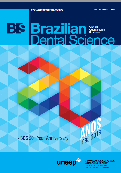Effect of the mixing method on the dimensional stability of dental stones
DOI:
https://doi.org/10.14295/bds.2018.v21i4.1616Abstract
The aim of this study was to evaluate the influence of mixing method and the empiric water/powder ratio on the dimensional change of two types of dental stones (type III and type IV) at different setting times: baseline, loss of brightness, initial and final setting (1/4 and 1pound Gilmore´s needle, respectively) and, after 48 hours at 37°C. Five mixing methods were used: Gc – manufacturer´s recommendation, G1 – weighed powder/ empiric water volume and powder on water, G2 - weighed powder/ empiric water volume and water on powder, G3 – empiric powder volume, graduated water and powder on water, G4 - empiric powder volume, graduated water and water on powder. The linear expansion was measured according to ISO 6873. The expansion values (x10-2mm) were analyzed by Two-way ANOVA and Tukey HSD test (?=0.05). For type III, the results showed significance for both factors and for interaction; for type IV, only the time were significant (p<0.05). Limited by methodology, it could be concluded that both dental stones expanded more than the recommended by ISO. The expansion of type III was dependent on the mixing method, and once correct consistency is reached with type IV, there is no influence of mixing method on dimensional stability.
Keywords
Gypsum; Dental stones; Expansion behavior.
Downloads
Downloads
Published
How to Cite
Issue
Section
License
Brazilian Dental Science uses the Creative Commons (CC-BY 4.0) license, thus preserving the integrity of articles in an open access environment. The journal allows the author to retain publishing rights without restrictions.
=================




























